The Koreans look to make up on lost time with the extrovert Hyundai Kona compact SUV
WHAT IS IT?
The Kona draws a bead on the best compact SUVs – cars like the Mazda CX-3 and the Toyota C-HR – offering a distinctive look, sturdy mechanicals, an attractive warranty and stacks of gear. Two engines, two chassis layouts and three trim levels deliver plenty of customer choice.
WHY WE’RE TESTING IT
The bar in the compact SUV class has been jacked up pretty high in the last couple of years, so we’re curious to see if Hyundai can score a meaningful hit on what’s become a fast-moving target.
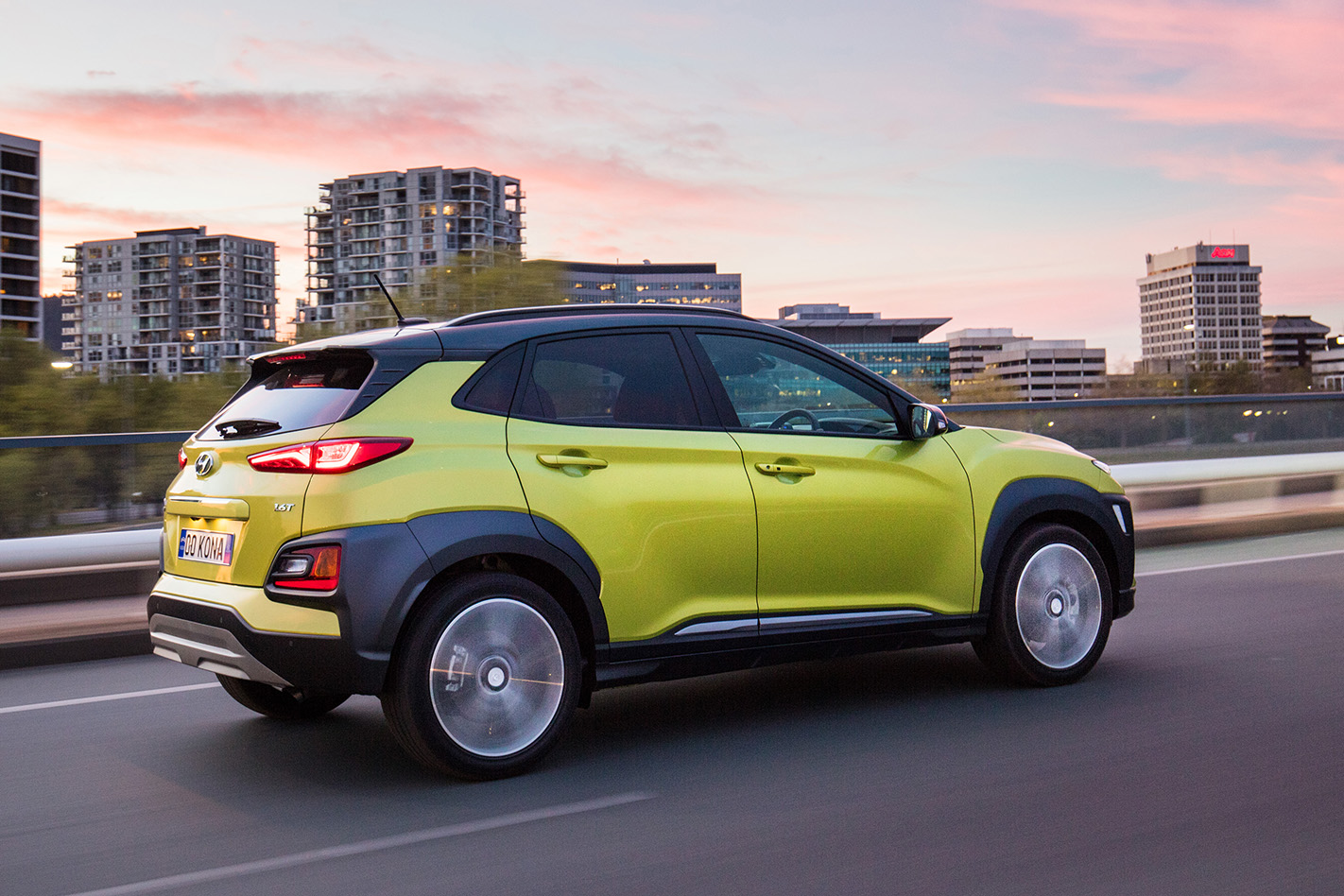
MAIN RIVALS
Honda HR-V, Mazda CX-3, Mitsubishi ASX, Subaru XV, Toyota C-HR
THE WHEELS VERDICT
If you’re a harsh marker, it’d be hard to escape the conclusion that the Hyundai Kona moves the compact SUV game on in no particular regard. Some rivals are bigger, some are better looking. You can buy cheaper and you can choose other models that are better to drive.
Where the Kona scores is in delivering enough on every key buying criterion to lever itself into contention. It’s an endearing thing that has no serious vices and which promises a temptingly hassle-free ownership experience. That ought to be enough to guarantee success but, given how late it is to market, it’d be understandable if you expected more.
PLUS: Bold styling, interior space, 1.6T engine’s zest, equipment on upper-spec models
MINUS: Inelegant body control, unadventurous interior, space-saver spare, odd spec omissions
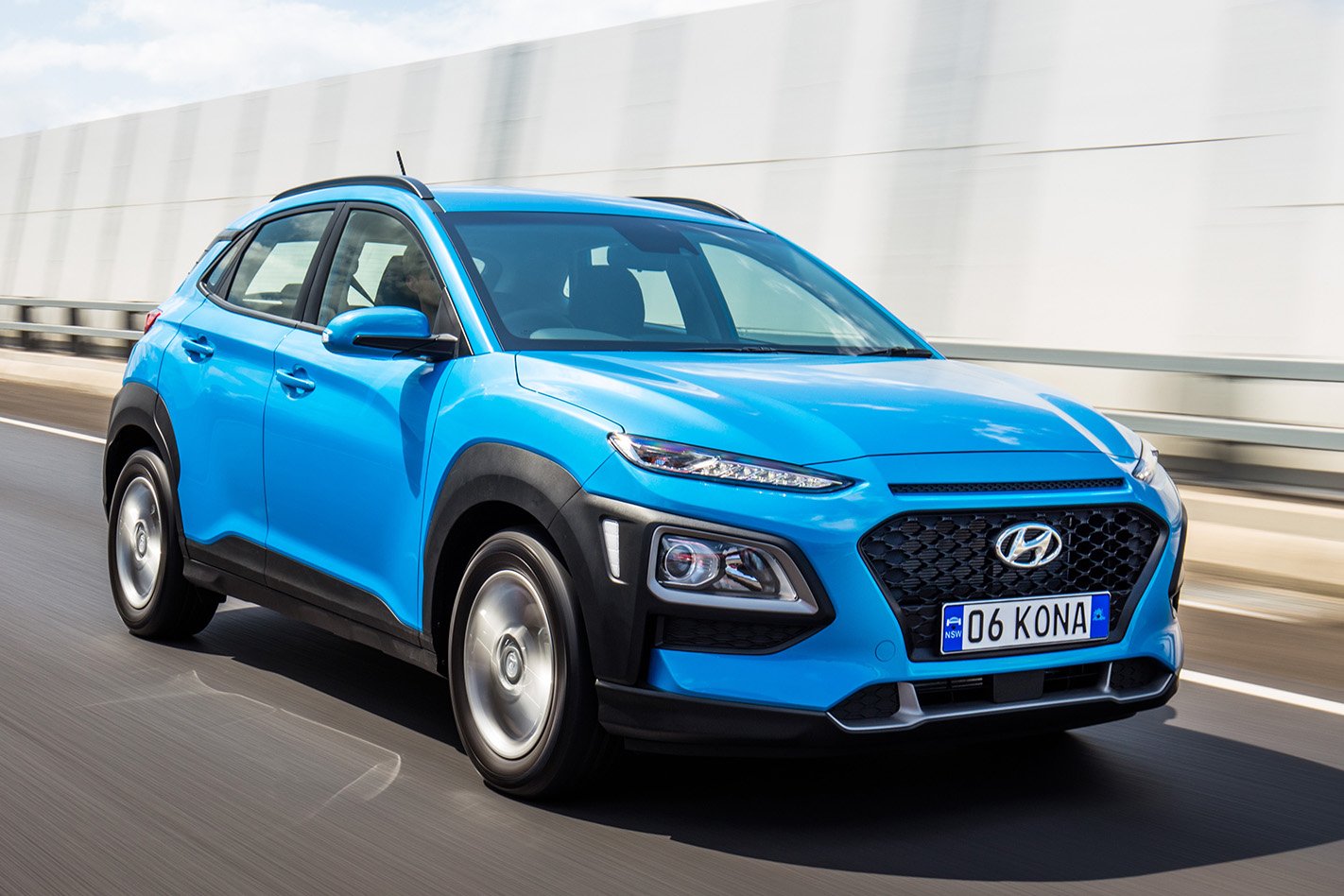
THE WHEELS REVIEW
WHEN asked whether the Kona could hope to beat the sales of rivals like the Mazda CX-3 and Mitsubishi ASX, Hyundai Australia’s chief executive, JW Lee, appeared momentarily affronted. “Why not?” he shrugged, regathering his composure. “It’s a better car.” Confidence is clearly not in short supply.
Timeliness, on the other hand, is. Since 2011 there’s been a massive explosion in the Aussie compact SUV market, registrations increasing from less than 20,000 to more than 90,000 cars per year. As Hyundai’s Japanese rivals carved up this lucrative pie between them, the Koreans sat on their hands.
Lee used the example of Netscape Navigator, one of the first web-browsers, as a case study, citing that it had then been overtaken by Johnny-come-latelies such as Internet Explorer, Chrome and Firefox. The thing is, in order to replace the incumbent champ there needs to be some demonstrably superior point of difference.
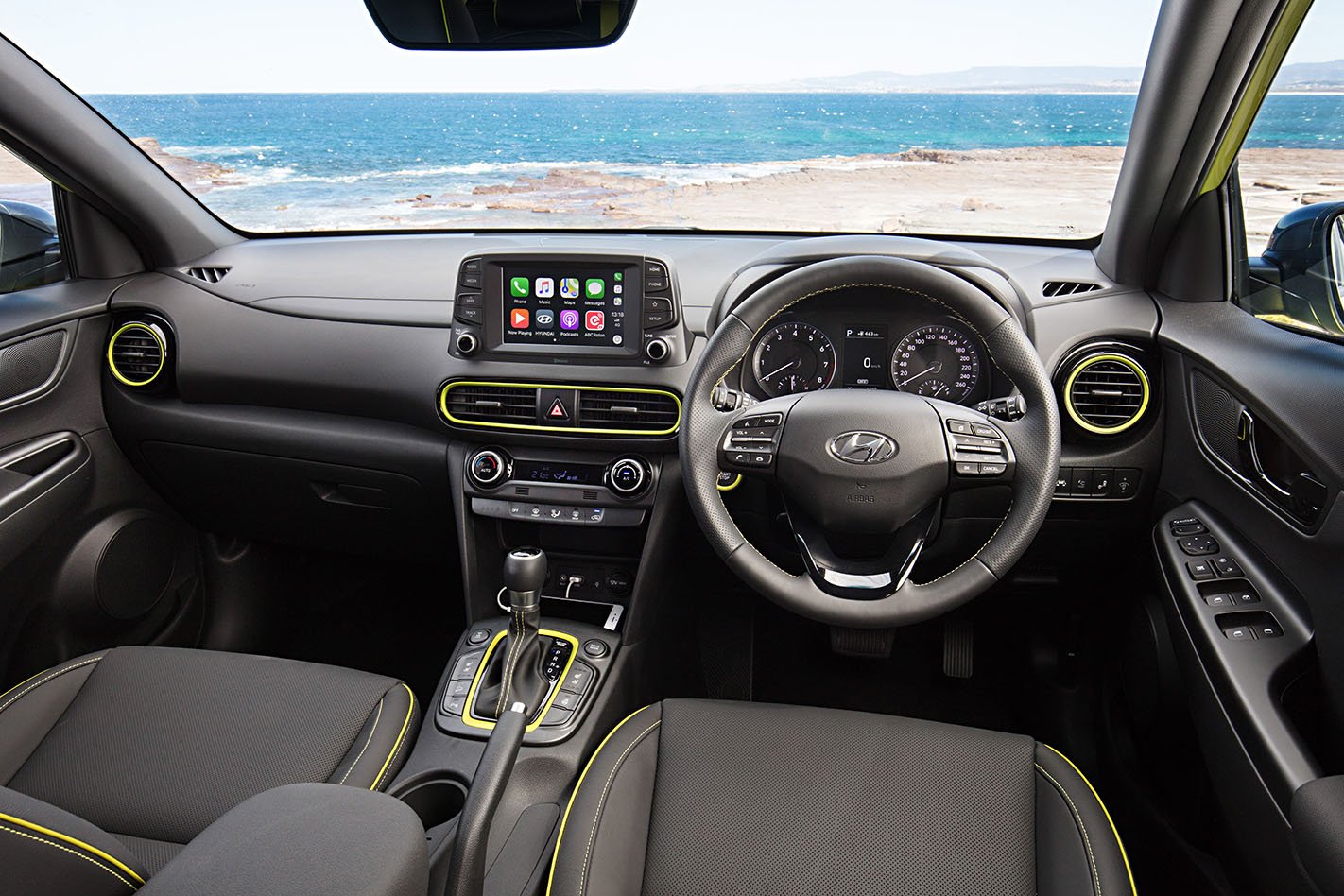
At first acquaintance, the Kona struggles to express such obvious superiority. Based on a modified version of the PD platform that underpins the i30 hatch, it’s a distinctive looking thing, with striking body armour, a chunky, purposeful stance, a sleek glasshouse and neat detailing such as the split daytime running lights and main driving lamps.
It has top notes of Citroen about some of the styling flourishes, albeit ones that have been toned back a few degrees.
At 4165mm in length, 1800mm in width and 1565mm in height, the Kona’s 110mm shorter than a CX-3, but boasts a 30mm longer wheelbase and measures 35mm wider too, resulting in a cabin that feels airier. The flipside of this is that with the wheels pushed out to each corner and passenger cell space prioritised, luggage space suffers. Except that it doesn’t, the Kona delivering 361 litres with the rear seats in place, compared to the Mazda’s measly 263-litre capacity. Both cars use a space-saver spare to do this, rather undermining the Kona’s outdoorsy brief, especially as the i30 hatch gets a full-size item.
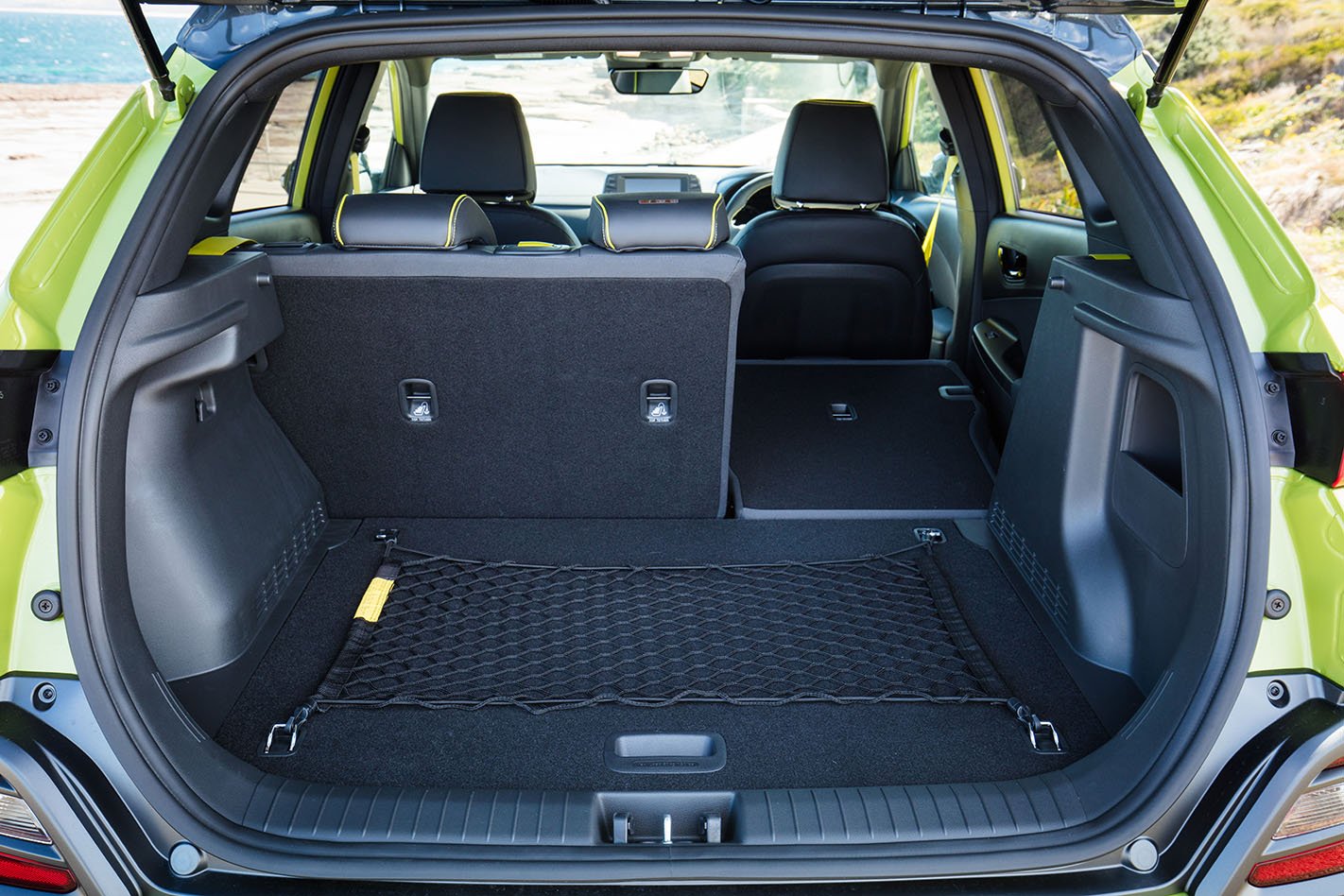
Buyers get to choose between a 110kW 2.0-litre normally aspirated engine, paired with a front-wheel drive chassis and a six-speed automatic gearbox or, if you’re feeling a few grand flusher, a 130kW 1.6-litre unit with all-wheel drive underpinnings and a 7-speed twin-clutch transmission. Hyundai also offers three trim levels – Active, Elite and Highlander – and all of these trims are offered with either engine.
Strictly speaking there are three and a half trim levels, as the entry-level Active can also be specified with a $1500 SmartSense safety pack which includes a suite of features such as blind spot monitoring, rear cross traffic alert, lane keep assist, forward collision warning, AEB, driver attention warning and, as a bonus, heated and folding door mirrors.
The Elite trim features this pack as standard, the alloys grow an inch to 17-inch, and you get leather, climate control, keyless go, and some slicker exterior garnishes amongst others. The top Highlander trim gets the options list shoehorned in, with a new to Hyundai head-up display, 18-inch wheels, a 4.2-inch colour TFT ‘supervision cluster’ between the dials, heated and ventilated front seats, a heated steering wheel, LED lights and a Qi wireless phone charging pad.
Prices start at $24,500 for the entry-level 2.0 Active and top out at $36,000 for the 1.6T Highlander.
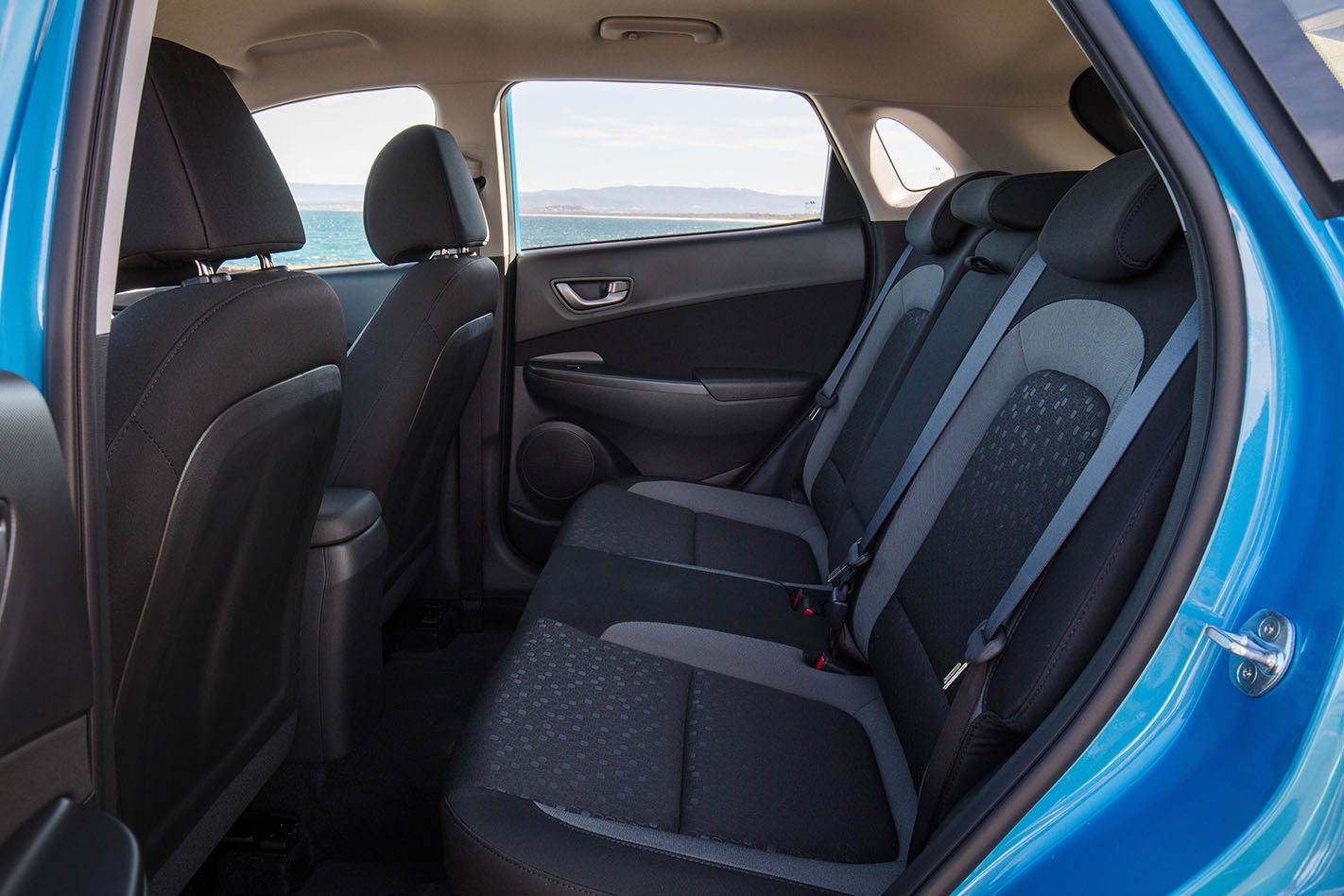
The 1.6-litre turbo engine, a similar unit to that found in the bigger Tucson, feels peppy when asked to shunt 1414kg of Kona up the road and the sprint to 100km/h will detain you for just 7.9 seconds. With 265Nm arriving at just 1500rpm, it rarely feels short of zip, but the twin-clutch transmission can be a little reluctant to downshift in automatic mode, even when set to sport.
At times, it seems as if the car is deliberating on its transmission, rear axle deployment and electronic stability control strategies before finally deciding upon a solution some way after corner exit. With no wheel-mounted paddles, keen drivers will recourse to the stick, pulling back to change down the box.
The 2.0-litre engine that 80 percent of buyers will choose is a good deal more vocal when pushed, but the six-speed automatic feels a suitable partner, giving the front-wheel drive car a relaxed loping nature. Here, 100km/h arrives in 10 seconds and the arrival of peak torque is a similarly languid affair, the 180Nm serving waiting until 4500rpm to make an appearance.

Peak power is at a nosebleed 6200rpm, a zone on the tacho you’ll rarely feel inclined to explore. Both cars feature a drive mode select switch that shuffles between Eco, Comfort and Sport modes. This alters transmission shift points, steering weighting, throttle and engine maps but doesn’t back off the stability control settings.
Delivering a definitive verdict on ride quality proved to be a tough assignment. Many of the test vehicles were riding on Nexen tyres, which were noisy and unimpressive in terms of grip. Hyundai maintains that customer cars will get Hankooks for 16 and 18-inch wheel choices and Continentals for 17-inch rims.
The Contis we tried were a far more impressive set of rubberwear, quelling road noise and offering a more malleable feel when cornered hard.
At this point it’s worth pointing out that the front-drive Kona and the all-wheel drive model have very different rear suspension architectures. The front driver gets a cheaper and simpler torsion beam rear end, while the all-paw variant gets a more sophisticated dual-arm multi-link arrangement. That said, Hyundai has done a good job in tuning the torsion beam and in everyday driving there’s not a lot to choose between the two. Only a modest increase in noise from the luggage bay differentiates the two.

Ride quality is firmish but not intrusive, only sharper road imperfections sending a jolt through the superstructure. Body control is about on a par with a Mitsubishi ASX, the Kona lacking that chuckable, tied-down junior hot hatch feel of a Mazda CX-3.
Much has been made of the Aussie-tuned suspension, the local chassis team going through 13 different front and 29 rear shock absorber combinations and appraising two different stabiliser bars, but fitting non-production standard tyres then renders this largely moot from a tester’s perspective. The electrically-assisted steering has a quick ratio but feels gluey as you wind on more lock. The brakes are beyond reproach, with an excellent pedal feel and strong performance.
The cabin will be familiar to most i30 drivers, offering much the same basic architecture, with a few changes to the HVAC controls and the instrument cowling, making space for the Highlander’s head-up display. Space in the rear is very good for a car of this size, two six-footers easily able to sit in tandem.
Front headroom is also excellent and aside from the inconveniently-sited starter button on upper-spec models, the ergonomics are sound. Many manufacturers could learn a few lessons in wheel-mounted controls from Hyundai.

Intriguingly, no version of the Kona comes with built-in sat nav. Hyundai has decided that most users prefer to port the nav from their phones, all cars being fitted with standard Apple CarPlay and Android Auto integration. The voice control button on the steering wheel then directly interacts with Siri or your friendly ‘droid, marshalling many of the phone and music selection functions.
Identifying the sweet spot in the Kona range is tough. If pushed, I’d nominate entry-level 2.0-litre and all the bells and whistles for the 1.6T version. The latter pushes pricing up towards Hyundai Tucson Elite levels, which could prove a diversion. For what it’s worth it’s also a little north of Mazda’s range-topping petrol-engined CX-3 Akari, which will doubtless raise a few eyebrows. We’re looking forward to getting these contenders into a head to head at some point in the not-too distant future. The Kona certainly has enough about it to give the baby Mazda something serious to contend with.
While it may not leap straight to the top of the class, I’m sure you’ll be seeing a lot of these on Aussie roads very soon. Despite its chief exec’s bold proclamation, that’s something Hyundai Australia looks set to be content with. The Kona might have been late to the party but, hey, if you’re there before it’s over, you’re on time.
Vote for the Hyundai Kona to win the 2018 Wheels Car of the Year Readers’ Choice competition
SPECS
Model: Hyundai Kona 1.6T Highlander Engine: 1591cc 4cyl, dohc, 16v turbo Max power: 130kW @ 5500rpm Max torque: 265Nm @ 1500-4500rpm Transmission: 7-speed twin-clutch Weight: 1414kg 0-100km/h: 7.9sec Economy: 6.7L/100km (claimed) Price: $36,000 On sale: Now






